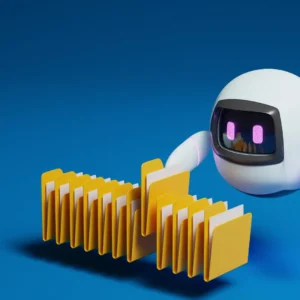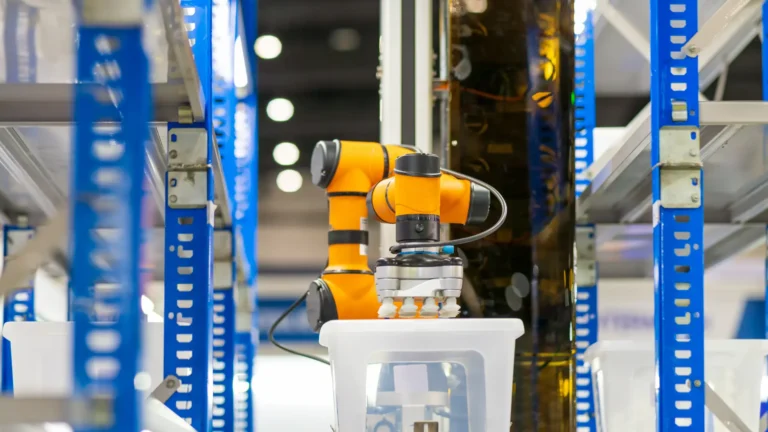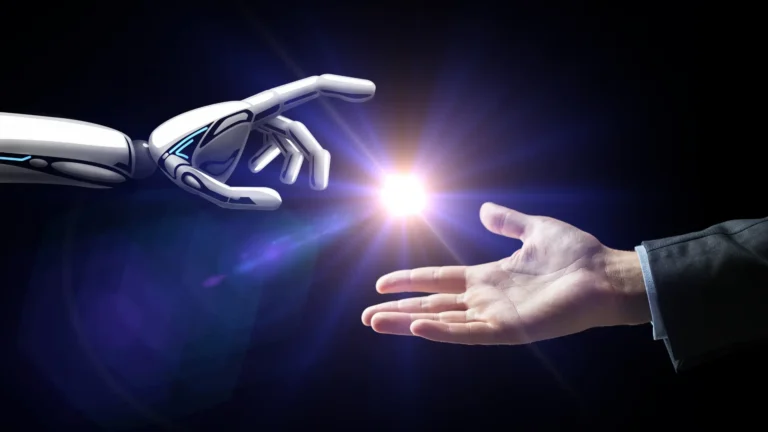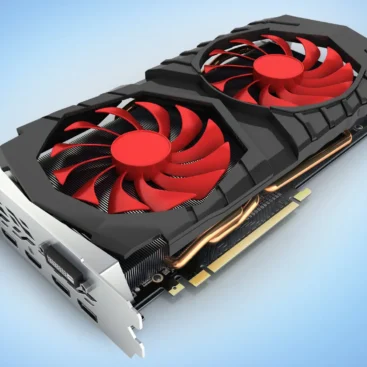
Robotics Evolution: Advancing Automation with AI
Executive Summary
This overview provides an in-depth look at the evolution of robotics, emphasizing the integration of artificial intelligence (AI) and its significant impact on automation. It traces the journey from the early days of industrial robotics to the advent of collaborative robots, or “cobots,” that work alongside humans. The integration of AI and machine learning has notably enhanced robots’ capabilities, enabling real-time perception, learning, and adaptation.
We discuss the role of deep learning and neural networks in advancing robots’ abilities and facilitating human-machine interactions. This analysis also explores the significant strides made by robotics in the service and healthcare sectors, as well as emerging trends in robotics, including soft robotics, swarm robotics, and bio-inspired designs.
Additionally, we address the social, cultural, and ethical implications of integrating robots into society, the need for sustainability in robotics, and the complex ethical and legal questions raised by increasing robot autonomy. The importance of education and workforce development in preparing for a future shaped by robotics is underscored, along with the necessity for global perspectives and collaborations in advancing robotics research, development, and regulation.
From Fiction to Reality: The Power of Robotics and AI
Robotics, once confined to science fiction alone, has seen remarkable advancements over the past few decades. From industrial automation to healthcare, robotics has permeated various sectors, revolutionizing how tasks are approached and complex problems are solved. Central to this transformation is the integration of artificial intelligence (AI), propelling robotics to new heights by enabling machines to perceive, learn, and adapt in previously unimaginable ways.
The Rise of Industrial Robotics
The origins of modern robotics can be traced back to the industrial revolution, where the need for automation and efficiency spurred the development of mechanical arms and programmable machines. These early robots were designed to perform repetitive tasks with precision, revolutionizing manufacturing processes and boosting productivity.
One iconic example is the automotive industry, where robotic arms have become instrumental in tasks such as welding, painting, and assembly. The Unimate, introduced in 1961 by American engineer Joseph Engelberger, is widely regarded as the first industrial robot. Adopted by General Motors for tasks like lifting and stacking hot metal pieces, it marked a pivotal moment in manufacturing automation.
Today, industrial robots have evolved into highly sophisticated systems capable of performing complex tasks with remarkable accuracy and speed. Advanced sensors, vision systems, and sophisticated programming enable these robots to adapt to changing conditions and handle intricate tasks such as precision assembly and quality control.
Collaborative Robots: Bridging the Gap
As robotics technology advanced, a new breed of robots emerged, designed to work alongside humans in shared workspaces. Known as collaborative robots or “cobots,” these robots prioritize safety and intuitive operation, allowing for seamless human-robot collaboration.
Cobots are equipped with advanced sensors and control systems that enable them to sense and respond to human presence and movements, ensuring safe and efficient cooperation. This innovation has opened new possibilities for robot deployment in industries where tasks require a blend of human dexterity and robotic precision, such as small-scale manufacturing, healthcare, and service sectors.
One notable example is the deployment of cobots in automotive assembly lines, where they work hand-in-hand with human workers, handling tasks that require precision and repetition while allowing humans to focus on more intricate and cognitively intensive tasks

AI and Machine Learning: The Game-Changers
The integration of artificial intelligence (AI) and machine learning (ML) has been transformative for robotics, propelling the field into an era of unprecedented capabilities. By leveraging advanced algorithms and vast amounts of data, robots can now perceive their environment, learn from experiences, and adapt their behavior in real-time.
Computer vision, a branch of AI enabling machines to interpret and understand digital images and videos, has significantly enhanced robot perception. Robots equipped with advanced vision systems can navigate complex environments, recognize objects and patterns, and even interpret human gestures and facial expressions.
Machine learning algorithms, particularly deep learning techniques, have enabled robots to learn and improve their performance over time. Rather than relying solely on predefined programming, robots can now analyze data, identify patterns, and make intelligent decisions based on learned experiences.
A compelling example of AI-powered robotics is the field of autonomous vehicles. Self-driving cars, once a futuristic concept, are now a reality thanks to the integration of advanced sensors, computer vision, and machine learning algorithms. These vehicles can perceive their surroundings, interpret traffic patterns, and navigate roads with remarkable precision, constantly learning and adapting to new situations.
Deep Learning and Neural Networks
Deep learning, a subset of machine learning, has revolutionized the capabilities of robots, particularly through neural networks. These complex models, inspired by the human brain, enable robots to process and interpret vast amounts of data in a way that mimics human cognition. In computer vision, this has allowed robots to recognize objects, understand scenes, and navigate spaces with unprecedented accuracy. Advancements in natural language processing empower robots to understand and generate human language, facilitating seamless interactions between humans and machines.
Service and Healthcare Robotics
Beyond industrial and collaborative applications, robotics has made significant strides in the service and healthcare sectors, enhancing efficiency, accessibility, and quality of life.
Service robots, designed to assist humans in various tasks, have become increasingly prevalent in sectors such as hospitality, retail, and personal care. From robotic floor cleaners and delivery robots to interactive customer service assistants, these robots are revolutionizing how we interact with and receive services.
In healthcare, robotics has the potential to transform patient care and improve medical outcomes. Surgical robots, equipped with advanced imaging and precision control systems, enable minimally invasive procedures with enhanced accuracy and reduced recovery times. Rehabilitation robots assist in physical therapy and aid patients in regaining mobility and independence.
Moreover, social robots designed to interact and engage with humans are being explored for applications such as elderly care, autism therapy, and mental health support. These robots can provide companionship, facilitate communication, and even monitor health conditions, offering a new frontier in personalized care.
Case Study: Robotics in Manufacturing
In the automotive industry, robotics has revolutionized manufacturing processes, leading to significant improvements in efficiency and productivity. One notable case study is the adoption of robotic arms for welding and assembly tasks at a leading car manufacturing plant.
Before the introduction of robotics, these tasks were labor-intensive and prone to errors, resulting in production delays and quality issues. However, with the implementation of robotic welding cells and assembly lines, the manufacturing process has become highly automated and streamlined.
Robotic arms equipped with advanced sensors and precision control systems can perform welding and assembly tasks with unparalleled accuracy and speed. These robots work seamlessly alongside human workers, handling repetitive and physically demanding tasks while ensuring consistent quality and safety standards.
As a result of robotics integration, the automotive manufacturer has experienced a significant increase in production output and product quality. Moreover, the automation of these tasks has reduced the risk of workplace injuries and improved worker satisfaction by allowing employees to focus on more complex and value-added activities.
User Perspective: Robotics in Healthcare
Robotic-assisted surgery has transformed the way we approach complex procedures in healthcare. With the assistance of robotic systems, surgeons can perform surgeries with increased precision and control, leading to better patient outcomes. The intuitive interfaces and advanced features of robotic platforms have streamlined surgical workflows, allowing for more efficient and effective procedures.
Moreover, robotics has expanded our capabilities in areas such as telemedicine and remote patient monitoring, allowing us to reach patients in underserved areas and provide specialized care from a distance. The integration of robotics into healthcare represents a significant step forward in improving patient care and advancing medical technology.”
This perspective underscores the transformative impact of robotics in healthcare, highlighting the enhanced capabilities and improved patient care that robotics technology brings to the medical field.
Emerging Trends and Technologies
Recent years have witnessed an explosion of innovation in robotics, driven by advancements in materials science, sensor technology, and artificial intelligence. Emerging trends such as soft robotics, swarm robotics, and bio-inspired designs are redefining our conception of what robots can be and do.
Soft robots mimic the flexibility and adaptability of biological organisms, enabling them to navigate complex environments and interact safely with humans. Swarm robotics leverages principles of collective behavior observed in natural systems to coordinate large groups of robots to accomplish tasks efficiently and robustly. Bio-inspired designs draw inspiration from nature to develop robots with capabilities such as flight, agility, and resilience, opening new frontiers in applications ranging from space exploration to environmental monitoring.
Human-Robot Interaction
Research in Human-Robot Interaction (HRI) focuses on understanding how humans perceive and interact with robots, aiming to design robots that are intuitive, socially adept, and capable of understanding and responding to human emotions and intentions. Ethical considerations such as privacy, safety, and trust play a central role in shaping HRI research and development, as designers strive to create robots that respect human autonomy and dignity while enhancing productivity and quality of life.

Global Perspectives on Robotics
The landscape of robotics research, development, and regulation varies widely across different countries and regions. While countries such as Japan and South Korea have long been leaders in robotics innovation, emerging economies such as China and India are rapidly investing in robotics technology to drive economic growth and address societal challenges.
International collaborations and initiatives, such as the International Federation of Robotics (IFR) and the Global Forum on AI for Humanity, facilitate knowledge sharing and collaboration among researchers, policymakers, and industry stakeholders. However, disparities in access to resources and expertise raise concerns about equity and inclusion in the global robotics community, highlighting the need for concerted efforts to bridge the digital divide and promote diversity in robotics.
Education and Workforce Development
As robotics technology continues to advance, the need for a skilled workforce capable of designing, building, and operating robots becomes increasingly urgent. STEM education and vocational training programs play a critical role in preparing individuals for the future of work in a roboticized world. Initiatives such as robotics competitions, maker spaces, and coding clubs provide hands-on learning opportunities for students to develop technical skills and creative problem-solving abilities.
However, addressing the digital divide and ensuring equitable access to education and training opportunities remain ongoing challenges, particularly in underserved communities and marginalized populations.
Social and Cultural Implications
The integration of robots into society raises profound social and cultural implications that extend beyond technical considerations. Robots challenge traditional notions of human identity, autonomy, and agency, prompting philosophical reflections on what it means to be human in an increasingly automated world.
Cultural narratives, artistic expressions, and media representations shape public perceptions of robots and AI, influencing societal attitudes and behaviors towards these technologies. As robots become more integrated into our daily lives, it is essential to critically examine the social and cultural norms that shape our interactions with robots and to foster inclusive and human-centered approaches to robotics design and deployment.
Sustainability and Responsible Innovation
The pursuit of robotics innovation must be guided by principles of sustainability and responsible stewardship of resources. Robots have the potential to contribute to sustainable practices in industries such as agriculture, renewable energy, and waste management, helping address global challenges such as climate change, resource scarcity, and environmental degradation.
However, the environmental footprint of robotics technology, including energy consumption, material usage, and end-of-life disposal of robots, must be carefully managed to minimize negative impacts on the planet. Responsible innovation requires collaboration between industry, academia, government, and civil society to develop and implement sustainable robotics solutions that balance economic, environmental, and social considerations.
Ethical and Legal Considerations
The increasing autonomy and ubiquity of robots raise complex ethical and legal questions that require careful consideration and deliberation. Issues Such as algorithmic bias, accountability, and liability challenge traditional notions of responsibility and agency in human-robot interactions.
Frameworks for ethical robot design and operation, such as the IEEE Ethically Aligned Design initiative and the EU’s Ethics Guidelines for Trustworthy AI, provide guidelines and principles to guide responsible innovation and deployment of robotics technology. However, translating ethical principles into actionable policies and regulations remains a daunting task, requiring collaboration between policymakers, ethicists, technologists, and civil society to navigate the ethical complexities of the robotic age.
Economic Impact
Exploring the economic implications of robotics adoption offers a comprehensive perspective on its far-reaching effects on society and the economy. While robotics innovation undoubtedly creates opportunities for job creation in fields such as robotics engineering, programming, and maintenance, it also brings about workforce displacement as certain tasks become automated. However, the overall economic impact of robotics extends beyond immediate job changes, encompassing broader market opportunities and increased efficiency in industries ranging from manufacturing to healthcare. By examining these economic dynamics, policymakers, businesses, and communities can better anticipate and navigate the transition towards a more automated future, ensuring that the benefits of robotics innovation are maximized while addressing any associated challenges.
Applying Robotics in Computer Manufacturing
The computer manufacturing industry can draw several valuable lessons from the advancements and experiences of the robotics industry. By examining how robotics has integrated artificial intelligence (AI), embraced innovation, and addressed various challenges, the computer manufacturing sector can enhance its processes and products. Here are key takeaways:
1. Integration of Artificial Intelligence (AI)
Robotics has significantly benefited from the integration of AI, which has improved automation, precision, and adaptability. Similarly, computer manufacturers can leverage AI to optimize production lines, enhance quality control, and predict maintenance needs. AI can also assist in designing more efficient computing systems and improving customer support through intelligent virtual assistants.
2. Emphasis on Collaboration and Safety
The development of collaborative robots, or “cobots,” emphasizes the importance of safety and seamless human-robot interaction. The computer manufacturing industry can adopt similar collaborative technologies to create safer and more efficient work environments. By incorporating advanced sensors and safety protocols, manufacturers can ensure the well-being of workers while enhancing productivity.
3. Adoption of Advanced Automation
Robotics has transformed industries through advanced automation technologies, enabling higher precision and speed in manufacturing processes. The computer manufacturing sector can implement similar automation solutions to streamline assembly lines, reduce error rates, and increase production throughput. Automation can also facilitate customization and scalability in manufacturing operations.
4. Focus on Continuous Learning and Adaptation
Robots equipped with machine learning capabilities can continuously learn and adapt to new situations, improving their performance over time. Computer manufacturers can adopt this approach by integrating machine learning algorithms into their systems to optimize processes, detect anomalies, and adapt to changing market demands. Continuous learning can also enhance product development cycles and innovation.
5. Exploration of Emerging Technologies
Robotics has embraced emerging technologies such as soft robotics, swarm robotics, and bio-inspired designs. The computer manufacturing industry can benefit from exploring these and other cutting-edge technologies, such as quantum computing and neuromorphic engineering. By staying at the forefront of technological advancements, manufacturers can develop next-generation computing solutions.
6. Addressing Ethical and Social Implications
The robotics industry has faced various ethical and social challenges, prompting the development of frameworks and guidelines for responsible innovation. Similarly, the computer manufacturing industry must address ethical concerns related to AI, data privacy, and environmental impact. By adopting ethical design principles and engaging in transparent practices, manufacturers can build trust and ensure sustainable growth.
7. Importance of Workforce Development
The robotics industry has faced various ethical and social challenges, prompting the development of frameworks and guidelines for responsible innovation. Similarly, the computer manufacturing industry must address ethical concerns related to AI, data privacy, and environmental impact. By adopting ethical design principles and engaging in transparent practices, manufacturers can build trust and ensure sustainable growth.
8. Global Collaboration and Standards
Robotics has benefited from international collaborations and standardization efforts. The computer manufacturing industry can similarly foster global partnerships and participate in developing international standards. Collaboration with global stakeholders will facilitate knowledge sharing, innovation, and the harmonization of regulations, driving the industry forward.
Looking Ahead
The journey of robotics from its early industrial roots to its current state of advanced integration with artificial intelligence reflects a remarkable evolution in technology. The fusion of automation and AI has not only enhanced the capabilities of robots but has also expanded their applications across diverse industries, revolutionizing workflows and redefining possibilities.
As we look to the future, it is imperative to confront the complex challenges and opportunities presented by robotics. Addressing ethical, social, and cultural implications, promoting sustainability, and ensuring inclusive access to education and workforce development are essential aspects of responsible innovation.
By embracing collaboration, embracing innovation, and embracing a commitment to ethical and sustainable practices, we can harness the full potential of robotics to create a future where technology serves humanity’s collective interests. Through continued dialogue, cooperation, and ingenuity, we can navigate the complexities of the robotic age and build a more prosperous and equitable world for generations to come.
Recent Blogs
Unleashing the i7 Processor Power with Holoware
Choosing the Perfect IPS Screen Laptop by Holoware
Holoware - Choosing a Laptop with Dedicated Graphics Card
Holoware's Best Budget Laptop for Programming
i9 Processor Laptops: Power & Performance at Holoware
The Rise of Thin and Light Laptops at Holoware
Holoware: Why a 4GB Graphics Card for PC Is Essential
8GB DDR4 RAM for Laptop: Boost Performance with Holoware
Holoware's Latest Generation of Laptop
AI Indian Laptop: Holoware Sets a New Standard for Indian AI PCs
About Holoware
Products & Services
Useful Links
©2024 Holoware® Computers Pvt. Ltd. | Site Map | Privacy Policy | Terms & Condition





Location: Porur,Chennai
No of Openings: 1
Join our team as a Senior Accounts Executive, where you’ll manage client relationships and implement innovative financial strategies. Your expertise in analyzing account performance will drive growth and foster lasting partnerships. If you’re ready to make an impact, we want to hear from you.
Roles and Responsibilities:
- Daily Accounts Receivable Management: Execute daily credit accounting in Tally Prime to ensure accurate financial records.
- Accounts Receivable and Credit Control Management: Administer the accounts receivable process and implement credit control measures to optimize cash flow.
- Invoice Processing and Material Transfers: Handle invoice cancellations and efficiently oversee the transfer of materials to the warehouse.
- Sales Returns and Order Cancellations Management: Process sales returns, record entries, create Post Goods Issues (PGI), and reverse canceled orders for precise sales tracking.
- Dealer Loan Recovery Supervision: Manage the recovery of dealer loans, accurately reflecting these amounts as recoverable income.
- Dealer Debit Data Reporting: Upload monthly dealer debit information to Power BI through Microsoft Azure for accurate financial analysis.
- Bank Reconciliation Tasks: Conduct detailed bank reconciliations to ensure transaction accuracy and resolve any discrepancies.
- Customer Account Reconciliation: Reconcile customer accounts with the General Ledger (GL) to ensure data consistency and accuracy.
- General Ledger Review: Perform monthly reviews of GL accounts to ensure compliance and accuracy in financial reporting.
- Monthly Sales Report Preparation: Compile and present monthly sales flash reports, offering insights into sales performance and trends.
- Monthly Financial Closing Procedures: Manage the monthly closing process, finalizing financial statements and recording all transactions.
- Tax Compliance Management: Prepare and submit Tax Deducted at Source (TDS) returns and issue Form 16 and Form 16A for compliance purposes.
- Employee Payroll Administration: Oversee the timely and accurate processing of employee salaries in line with payroll policies.
- Project Bills and Payment Oversight: Oversee the management of project bills payable, ensuring timely processing of payments to vendors and contractors.
- Project Budget Allocation Management: Allocate project budgets according to expense categories, ensuring effective financial resource utilization.
- GST Compliance Oversight: Manage Goods and Services Tax (GST) returns and TDS calculations to ensure accurate reporting and compliance.
- Audit Coordination: Collaborate with internal and external auditors, providing all necessary documentation for smooth audit processes.
- Audit Process Coordination: Facilitate internal and Auditor General (AG) audits by preparing all necessary documentation for review.
- Government Fund Allocation Liaison: Work with government agencies to coordinate fund allocations, ensuring compliance with regulations.
- Monthly Management Information Reporting: Prepare and present detailed Monthly Management Information System (MIS) reports to senior management.
Key Skills:
- Accounting
- Financial Reporting
- Tally Prime
- Data Analysis
- Reconciliation
- Tax Compliance
- Negotiation
- Problem-Solving
- Time Management
- Team Collaboration
- Vendor Management
Location: Porur,Chennai
No of Openings: 4
Join our team as a Senior Hardware Engineer to design and optimize state-of-the-art computing systems. You’ll leverage your expertise to innovate hardware solutions, ensuring peak performance and reliability in our products. Collaborate with a talented team to tackle complex challenges and help shape the future of technology.
Roles & Responsibilities:
- Lead the assembly process of desktops, laptops, and servers ensuring adherence to technical specifications and quality standards.
- Supervise and train a team of assembly technicians and junior engineers, providing guidance and feedback.
- Collaborate with the R&D and design teams to implement manufacturing processes for new products.
- Develop and optimize workflow to increase efficiency and reduce assembly times and costs.
- Maintain detailed documentation of assembly procedures and product modifications.
- Conduct quality control checks and troubleshoot hardware issues before final product release.
- Ensure compliance with safety standards and regulations in the assembly line.
- Manage inventory of parts and tools required for assembly processes.
- Stay updated with industry trends, new technology, and best practices in hardware assembly.
Preferred candidate profile:
- Bachelor’s degree in Electrical Engineering, Mechanical Engineering, or a related field.
- Minimum of 5 years of experience in hardware assembly, preferably focusing on PCs, laptops, and servers.
- The maximum age limit is 42 years
- Proven track record of leading a team in a manufacturing or assembly environment.
- Strong technical skills with a deep understanding of computer hardware components and assembly techniques.
- Excellent problem-solving skills and attention to detail.
- Proficient in using assembly tools and equipment.
- Certifications related to hardware assembly or project management.
- Experience in an ISO-certified or other regulated environment.
Key Skills:
- Service Engineering
- Hardware Networking
- Computer Hardware
- Team Leading
- Chip Level Repairing
- After Sales – Service and Support
- Computer Assembling
Location: Porur,Chennai
No of Openings: 2
Seeking a Senior Executive – International Purchase to spearhead global procurement strategies and secure top-tier suppliers. Harness your expertise to drive cost efficiencies, negotiate high-impact deals, and ensure seamless cross-border operations. Ideal candidates excel in strategic sourcing and thrive in a dynamic, fast-paced environment. Elevate our international purchasing with your strategic vision and industry insight.
Roles and Responsibilities:
- Develop and implement procurement strategies that are cost-effective and aligned with the company’s production needs and budget constraints.
- Identify, evaluate, and select reliable vendors and suppliers. Negotiate contracts and terms of agreements to achieve favourable pricing and delivery terms.
- Maintain optimal levels of inventory to ensure uninterrupted production schedules while minimizing carrying costs and obsolescence.
- Ensure that all purchased items meet quality standards and specifications required by the production process.
- Monitor and control procurement budgets and expenditures. Implement cost-saving initiatives without compromising on quality or reliability.
- Coordinate with production planning and logistics teams to ensure timely availability of materials and components.
- Stay updated with regulatory requirements and ensure procurement activities comply with legal standards and company policies.
- Identify potential risks in the supply chain and develop mitigation strategies to avoid disruptions in production.
- Analyse procurement data and market trends to make informed decisions and optimize purchasing strategies.
- Build and maintain strong relationships with vendors, suppliers, and internal stakeholders to foster collaboration and achieve mutual goals.
Preferred Candidate Profile:
- Proven experience as a Purchase or in a similar role.
- Should have a strong International Procurement experience.
- Strong negotiation skills and the ability to build long-term relationships with suppliers.
- Excellent communication and interpersonal skills.
- Familiarity with supply chain processes and inventory management.
- Bachelors degree in Business Administration, Supply Chain Management, or relevant field.
Location: Porur,Chennai
No of Openings: 2
Dynamic Logistics Executive sought to streamline supply chain operations and optimize distribution networks. Leverage your expertise to drive efficiency, enhance customer satisfaction, and lead innovative solutions. Ideal candidates are proactive problem-solvers with a knack for strategic planning and team leadership. Join us to make a tangible impact in a fast-paced environment!
Roles and Responsibilities:
Imports:
- Receiving the documents from overseas Agents.
- Documents are forwarded to various Liner for IGM filing purposes.
- Follow up on the vessel status for all import shipments through online.
- Providing the vessel details and the IGM number to the consignee once their shipment arrives.
- Issuing the Delivery order to a variety of consignees.
- Regular communication with All Liners/Consignee & Overseas Agent for all Import Shipments.
- As per the Shipper Invoice & Packing List, have prepared the shipment checklist.
- Preparing the necessary documents for clearance purposes
- Regular interaction with Liner for all the shipments.
- BE filing follow-up with CHA and transport movement
- Follow up on the status of all the shipments and inform the same to the respective shipper
- Preparing the Invoices of Various parties.
- Planning for day-to-day clearance on a priority basis.
Exports:
- Booking the cargo for all export shipments to Liner / Consolidator.
- Arranging the Container Release order from the liner and forwarding to the Shipper or CHA
- Informing liner to post the form-13 to CHA ID
- Follow up the container to load on the booking vessel.
- Preparing the Bill of Lading through on-line to various sector
- Based on the Liner invoice, have generated our Invoice for Customers.
- Issuing the Bill of Lading/COO/SCOMET
- Co-ordinating with all Overseas agents/Liner / Shipper/CHA for all export shipments.
- Scrutiny the Freight rates from the Liner / Consolidator and provide the best rate to the shipper).
- SB filing follow-up with CHA and transport movement
Preferred Candidates Profile:
- Tally /SAP/ERP knowledge required.
- Should be strong in Shipping INCOTERMS
- Preparing the Profit & Loss for all shipments (Import & Export)
Location: Bangalore, Hyderabad & Mumbai
No of Openings: 5
We are seeking a Key Account Manager for Corporate Sales who plays a crucial role in driving revenue growth, maintaining strong client relationships, and ensuring customer satisfaction within key accounts. Their responsibilities require a blend of strategic thinking, interpersonal skills, and a deep understanding of both the client’s business and their own company’s offerings.
Preferred Candidate profile:
- Excellent communication, interpersonal and relationship-building skills
- Should have a strong experience in B2B sales.
- Ability to work both independently and collaboratively in a team setting.
- Keen analytical skills and a strategic mindset.
- Willingness to travel for business purposes.
- Proven track record in lead generation and communication
- Ability to work independently and collaboratively
- Experience in the IT hardware/ Technology industry is a plus
- Experience in handling the IT/ITES, Manufacturing, Engineering, Media, BFSI Enterprise accounts is a plus
- Knowledge of IT hardware products is a plus
- Languages: Local Regional language and English are a must; Tamil & Hindi will be an added advantage.
- Preferred experience is 5 to 12 years in the relevant field.
Roles & Responsibilities:
- Establishing and maintaining a strong rapport with the enterprise accounts and the Channel partners in the assigned territories.
- Develop and execute strategic plans to achieve sales targets and expand the company’s customer base within key accounts
- Responsible for selling Artificial Intelligence (AI) Laptops, PCs and other Business Laptop, Executive Laptop, Desktops & Workstations.
- Coordinate with internal teams to ensure contract specifications are met on schedule.
- Analyse market trends and competitor activities to adjust strategies accordingly.
- Create and present detailed reports and presentations for various stakeholders.
- Business Development, Meeting the customers F2F Daily.
- Getting new Logos, generating leads, and providing excellent customer service.
- Drive existing accounts and get new business through SI’s and Large partners.
Location: Porur,Chennai
Languages: Hindi, Kannada, Telugu, Malayalam
No of Openings: 5
We are seeking a motivated and detail-oriented Business Analyst to join our dynamic sales team. The Business Analyst will play a key role in supporting our sales representatives and ensuring smooth operations within the sales department. This position offers an exciting opportunity to contribute to the success of our sales initiatives and provide excellent customer service to our clients.
Roles and Responsibilities:
- Identify potential customers interested in laptops, desktops, and tablets.
- Reach out to these prospects via phone or email to introduce the products.
- Discuss with customers to determine their specific requirements and preferences.
- Recommend and demonstrate the laptops, desktops, and tablets that best fit their needs.
- Track and manage leads through the sales cycle using CRM tools.
- Negotiate terms and close sales for the desired devices.
- Maintain communication with clients to ensure their satisfaction and encourage repeat business.
- Provide updates on sales performance and progress towards targets.
- Coordinate with technical support and product teams to address any issues or questions.
- Prepare and manage quotes, orders, and other sales-related documentation.
Preferred Candidates Profile:
- A bachelor’s degree in business administration, marketing, or a related field is preferred.
- Hindi or other regional languages are preferred.
- Proven experience in a sales support or coordination role, preferably in the technology industry.
- Strong organizational skills with the ability to manage multiple tasks simultaneously and prioritize effectively.
- Excellent communication and interpersonal skills, with a customer-focused approach.
- Proficiency in Microsoft Office suite (Word, Excel, PowerPoint) and CRM software.
- Attention to detail and high accuracy in data entry and record-keeping.
- Ability to work independently and as part of a team in a fast-paced environment.
- Positive attitude, willingness to learn, and adaptability to changing priorities.
Perks and Benefits:
- Opportunity to work with cutting-edge technology and innovative products.
- Collaborative and supportive work environment.
- Career growth and development opportunities within a growing company.
- Make a meaningful impact by contributing to the success of our sales team and driving business growth.
Location: Bangalore & Kochi
No of Openings: 2
We are seeking a Government Sales Specialist with exceptional communication skills and a deep understanding of government operations and procurement processes. This role is ideal for individuals with a strong background in public administration or related fields, who are adept at strategic engagement and building a long-term governmental relationship.
Preferred Candidate profile:
- Proven track record in sales with a focus on government sector engagements.
- Able to manage the GeM (Govt e-Marketplace) portal and Govt tenders.
- Exceptional verbal and written communication skills.
- Strong experience working with CXOs & Procurement Managers.
- Should have a strong experience in stock & sell.
- Ability to work both independently and collaboratively in a team setting.
- Keen analytical skills and a strategic mindset.
- Willingness to travel for business purposes.
- Preferred experience is 5 to 12 years in the relevant field.
- Strong knowledge in handling the state & central government departments within the whole Kerala/Karnataka/Mumbai state.
Roles & Responsibilities:
- Develop and implement effective sales strategies tailored to government sectors.
- Navigate and comply with government procurement policies and regulations.
- Build and maintain robust relationships with key stakeholders within government entities.
- Responsible for selling Artificial Intelligence (AI) Laptops, PCs and other Business Laptop, Executive Laptop, Desktops & Workstations.
- Coordinate with internal teams to ensure contract specifications are met on schedule.
- Analyze market trends and competitor activities to adjust strategies accordingly.
- Create and present detailed reports and presentations for various stakeholders.
Location: Porur,Chennai
No of Openings: 5
As a Level 2 Customer Support Specialist, you will serve as the primary point of contact for customers requiring advanced technical support for desktop/laptop-related issues. You will troubleshoot, resolve, and escalate complex problems, providing exceptional customer service and ensuring customer satisfaction.
Roles and Responsibilities:
- Respond to customer inquiries via phone, email, or chat, resolving Level 2 technical issues related to desktop/laptop hardware, software, and peripherals.
- Troubleshoot and diagnose complex problems using advanced technical knowledge and tools.
- Provide timely and effective solutions, escalating issues to senior technicians or management when necessary.
- Document customer interactions, issues, and resolutions in our CRM system.
- Collaborate with internal teams (e.g., sales, technical) to resolve customer concerns and improve processes.
- Stay up-to-date with industry developments, new technologies, and company products/services.
- Meet or exceed customer satisfaction, first-call resolution, and other performance metrics.
Preferred Candidates Profile:
- 2+ years of experience in technical support, preferably in a desktop/laptop service company.
- Advanced knowledge of desktop/laptop hardware, software, and peripherals.
- Excellent problem-solving, analytical, and communication skills.
- Ability to work in a fast-paced environment, prioritizing tasks and managing time effectively.
- Strong customer service skills, with a focus on empathy and professionalism.





Sample Form
Rugged Laptop
Rugged Tablet
Tablets
Demo Available*
Inquire About Rental Options
Warranty Offers
- Extended Protection: Warranty offers cover repairs and replacements for hardware failures or defects, saving significant costs on expensive components.
- Professional Support: They provide access to authorized service centers and professional support, ensuring quality repairs with genuine parts.
Services with those steps are available
- Accidental Damage Coverage: Some warranties include coverage for accidental damage, such as drops or spills, providing extra protection beyond standard defects.
- Technical Support: Many warranties offer round-the-clock technical support to help with troubleshooting and resolving software or hardware issues.
- Data Recovery Services: In case of hardware failure, some warranty plans include data recovery services to help retrieve important files and documents.
Solution With 24/7 Support
- 24/7 Technical Support: Many warranty plans provide round-the-clock technical support to assist with troubleshooting and resolving software or hardware issues at any time.
- On-Site Repairs: Certain warranty plans offer on-site repair services, where technicians come to your location to fix issues, minimizing downtime.
- Loaner Devices: Some warranties provide loaner devices while your laptop is being repaired, ensuring you stay productive without interruption.
- Global Coverage: For frequent travelers, some warranty plans offer global coverage, ensuring you can get support and repairs no matter where you are
Get Started
Please enable JavaScript in your browser to complete this form. |


In 1994, Mr.Thangavel started Origin Information Technology (in partnership with Mr. Loganathan) to provide quality computer hardware sales and service. In the year 2022, the company name was changed to “Tinkas Industries Private Limited” to encompass its diversified activities. Mr. Thangavel feels that he can give back to his nation the growth it needs in many ways like providing employment opportunities to many, and doing CSR activities, etc. His goal is to make Tinkas a leader at the National and Internaltional levels.
Holoware CEO abut Tinkas CEO
“The CEO of Tinkas (Mr.Thangavel) is undeniably one of the most practical and resourceful individuals I’ve encountered in Tamil Nadu. His profound understanding of the industry coupled with his diverse business ventures truly exemplifies his wealth of knowledge. Partnering with Tinkas has been a delight, and we eagerly anticipate further growth and collaboration.”
Mr. Ketan Patel is an indomitable entrepreneur revolutionizing the landscape of electronic consumer products worldwide through an unparalleled ‘experiential journey.’ Leading Creative Newtech since 1992, he steered its growth from a Mumbai market trader to a distributor and Brand Licensee. As an alumnus of IIM-Bangalore, Mr Patel leads Creative Newtech with a focus on innovation and strategic leadership. Under his three-decade leadership, Creative Newtech has become India’s market leader, expanding globally across Hong Kong, the Middle East, and the SAARC region.”
Holoware CEO abut Creative Newtech CEO
“The CEO of Creative (Mr.Ketan Patel) is a highly knowledgeable leader, renowned for his expertise in distributorship. His intuitive knack for product selection and sales strategies, both in India and abroad, is impressive. Creative thrives as a powerhouse, fueled by its diverse team and collective expertise. We eagerly look forward to a promising future and further success in our collaboration with Creative.”


Inmac Computers Private Limited is a trailblazing name in the realm of IT services and solutions. With a remarkable inception in 1992 by visionary entrepreneurs Girish Babu and Asha Girish Babu, our company has consistently remained at the forefront of technological innovation, setting new standards for excellence in the industry.
Holoware CEO abut Inmac CEO
“Inmac’s CEO (Mr.Girish Babu) is one of the most humble and generous individuals I’ve ever had the pleasure of meeting. His leadership has been instrumental in steering his team to success, not just in Maharashtra but across various regions in India. Their financial stability over the years speaks volumes about his capabilities. It’s truly a delight to collaborate with someone of his caliber. I look forward to continued partnership with Inmac.”








